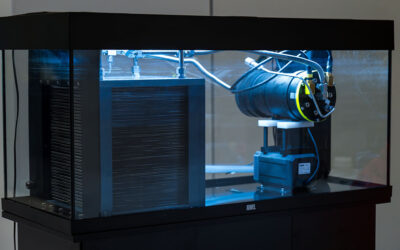Scientists have potentially overcome a major obstacle to making next-generation batteries composed of sulfur and lithium, which could store more than double the amount of energy than conventional lithium-ion batteries.
In recent years, demand has rapidly grown for new battery materials and designs that can outperform conventional batteries. In addition to a higher energy storage capacity, a key advantage of lithium–sulfur batteries is that they can be more environmentally friendly than the lithium–ion batteries we use today.
“Lithium–sulfur batteries use materials with lower environmental impact and are less reliant on scarce metals,” said Jun-Woo Park at the Korea Electrotechnology Research Institute (KERI) Next Generation Battery Research Center. “Sulfur, the primary active material, is inexpensive and widely available, unlike cobalt or nickel used in lithium-ion batteries.”
Despite the promise of this new battery technology, researchers have long faced a major hurdle in its commercialization — the charge and discharge process generates unwanted chemical reactions that degrade the battery’s lifespan and performance over time.
Park and colleagues have come up with a new battery design that could circumvent this.
“This design significantly enhances battery performance by addressing critical challenges,” he explained. “Our design also enables ultra-flexible batteries, making them suitable for wearable devices and other emerging technologies.”
Overcoming a long-standing problem
While the idea of lithium–sulfur batteries dates back to the 1960s, researchers have long faced significant barriers to making this technology commercially viable.
One of the biggest challenges researchers face with lithium-sulfur batteries is a chemical side reaction that forms molecules called polysulfides. As the battery charges and discharges, these polysulfides dissolve into the liquid electrolyte and move between the electrodes, causing unwanted chemical reactions.
This process, known as the “polysulfide shuttle effect” can break down key battery components over time, reduces the battery’s efficiency, shortens its lifespan, and makes it harder to maintain stable performance over multiple charge cycles.
Park and colleagues came up with a new design that could block the movement of polysulfides within the battery. This design relies on single-walled carbon nanotubes, which are made out of sheets of graphene that are rolled up to form tiny tube structures.
These nanotubes are known to enhance the performance of lithium–sulfur batteries thanks to their outstanding strength and electrical conductivity. But what makes the design innovative is that the nanotubes were chemically modified to carry oxygen atoms on their surface.
The oxygen can then bind to polysulfides and act as a filter that stops them from traveling through the battery. This allowed the scientists to build batteries that maintained over 85% of their initial energy capacity after 100 charge and discharge cycles — a significantly higher rate than that of earlier lithium–sulfur battery designs.
What’s more, integrating nanotubes within the battery made it possible to create flexible batteries with high energy capacity. The researchers built a prototype where multiple battery layers were assembled into a thick sheet that could store over 1 Ah, or about a quarter of the energy capacity of a common smartphone battery.
“Our batteries achieved a discharge capacity exceeding 1 Ah with excellent cycling stability, marking a significant step forward for next-generation energy storage solutions,” said Park. “We have laid the foundational framework that can be applied in actual industrial settings, marking a significant achievement that opens up the practical commercialization potential of next-generation lithium–sulfur batteries.”
The road to commercialization
While the new design developed by Park’s research group has opened up a new path for making commercial-grade lithium–sulfur batteries, more work will be needed to make this new technology viable.
The scientists will be working on further improving their design to maintain the battery’s capacity over a larger number of charging cycles. They will also conduct more work on safety, as batteries containing lithium can overheat, catch on fire and even explode when they are damaged or incorrectly used.
“For commercialization, achieving high energy density while increasing battery capacity is essential,” said Park. “To this end, we are optimizing electrode design and manufacturing processes to maximize capacity while maintaining performance.”
The new batteries are designed to have a lower environmental impact than conventional lithium–ion batteries, but they will still have their own footprint. The new batteries still contain lithium, which is currently extracted using mining methods that cause extensive deforestation and significant water pollution.
In addition, the chemical process the scientists used to modify the carbon nanotubes in their new battery design is quite energy intensive. Park stated that the environmental impact of these key components will need to be addressed, for instance with further research into recycling methods, to minimize the battery’s overall environmental footprint.
If the optimization efforts are successful, this type of battery would be ideal for developing aircraft for urban air mobility applications, where small aircraft are used to carry passengers within urban areas as an alternative to road traffic. In particular, the lightweight design of these new batteries could be critical to enable longer flight times. Plus, their flexibility would make it possible to seamlessly integrate the batteries within a variety of airframe designs.
“We are working closely with industry partners to scale up battery production and integrate our technology into various applications,” said Park. “We plan to continue enhancing the battery’s cycle life, safety, and energy density while exploring potential applications in electric vehicles, flexible electronics, and urban air mobility.”
Reference: Junyoung Heo et al., A Promising Approach to Ultra-Flexible 1 Ah Lithium–Sulfur Batteries Using Oxygen-Functionalized Single-Walled Carbon Nanotubes, Advanced Science (2024). DOI: 10.1002/advs.202406536

![[사진1]KERI 박준우(왼쪽 4번째) 박사팀이 탄소나노튜브와 산소 작용기를 결합한 기술로 차세대 리튬황전지의 한계를 극복했다. Scientists developing a lithium-sulfur battery.](https://www.advancedsciencenews.com/wp-content/uploads/2025/02/사진1KERI-박준우왼쪽-4번째-박사팀이-탄소나노튜브와-산소-작용기를-결합한-기술로-차세대-리튬황전지의-한계를-극복했다.jpg)















